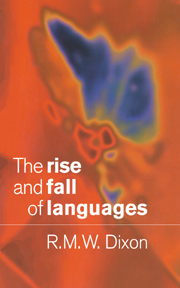Book contents
- Frontmatter
- Contents
- Acknowledgements
- 1 Introduction
- 2 Preliminaries
- 3 Linguistic areas and diffusion
- 4 The family tree model
- 5 Modes of change
- 6 The punctuated equilibrium model
- 7 More on proto-languages
- 8 Recent history
- 9 Today's priorities
- 10 Summary and prospects
- Appendix – where the comparative method discovery procedure fails
- References
- Index
Appendix – where the comparative method discovery procedure fails
Published online by Cambridge University Press: 05 June 2012
- Frontmatter
- Contents
- Acknowledgements
- 1 Introduction
- 2 Preliminaries
- 3 Linguistic areas and diffusion
- 4 The family tree model
- 5 Modes of change
- 6 The punctuated equilibrium model
- 7 More on proto-languages
- 8 Recent history
- 9 Today's priorities
- 10 Summary and prospects
- Appendix – where the comparative method discovery procedure fails
- References
- Index
Summary
The term ‘comparative method’ has been used in two distinct ways. In its original and widest sense it refers to a method of proving genetic relationships between languages. This involves the systematic comparison of grammatical forms and lexemes, establishing correspondence sets between phonemes, putting forward hypotheses concerning a putative proto-system and the changes through which the systems of modern languages developed (see, for example, Meillet 1925/1967).
‘Comparative method’ has also been used, in a narrower sense, to describe a set of discovery procedures which would automatically reconstruct the phonemes for a proto-language. This procedure was first put forth by Hoenigswald (1950), being directly analogised from the discovery procedures then in fashion for working out phonemes in synchronic linguistic analysis. Hoenigswald suggested that just as phonetically related phones that are in complementary distribution can be grouped together as allophones of one phoneme (as was believed at the time), so phonetically similar correspondence sets that are in complementary distribution should be grouped together as reflexes of a single proto-phoneme.
Hoenigswald's discovery procedure for comparative reconstruction rapidly gained acceptance. His own textbook (Hoenigswald 1960) stated the environment for a correspondence set in terms of other correspondence sets and looked for the grouping into proto-phonemes that gives the simplest overall phonemic system for the proto-language; there is an analogy to phonemic procedures but Hoenigswald did now imply that it is a problem of a different type from synchronic analysis. However, Hockett, in his textbook (1958: 485–505), went one step further and explained reconstruction by ‘the comparative method’ as if it were identical to an exercise in synchronic phonemic analysis; each distinct correspondence set relates to a phone in the proto-language and these are then grouped into phonemes in the familiar way.
- Type
- Chapter
- Information
- The Rise and Fall of Languages , pp. 149 - 152Publisher: Cambridge University PressPrint publication year: 1997



